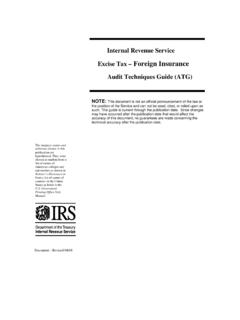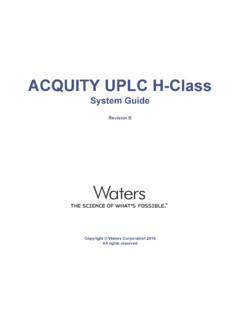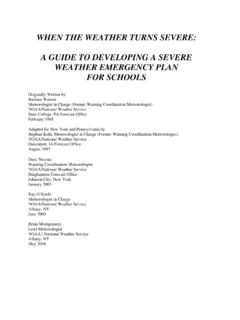Transcription of Of Strategies, Deliberate and Emergent Henry Mintzberg ...
1 Of Strategies, Deliberate and Emergent Henry Mintzberg ; James A. Waters Strategic Management Journal, Vol. 6, No. 3. (Jul. - Sep., 1985), pp. 257-272. Stable URL: Strategic Management Journal is currently published by John Wiley & Sons. Your use of the JSTOR archive indicates your acceptance of JSTOR's Terms and Conditions of Use, available at JSTOR's Terms and Conditions of Use provides, in part, that unless you have obtained prior permission, you may not download an entire issue of a journal or multiple copies of articles, and you may use content in the JSTOR archive only for your personal, non-commercial use. Please contact the publisher regarding any further use of this work. Publisher contact information may be obtained at Each copy of any part of a JSTOR transmission must contain the same copyright notice that appears on the screen or printed page of such transmission.
2 The JSTOR Archive is a trusted digital repository providing for long-term preservation and access to leading academic journals and scholarly literature from around the world. The Archive is supported by libraries, scholarly societies, publishers, and foundations. It is an initiative of JSTOR, a not-for-profit organization with a mission to help the scholarly community take advantage of advances in technology. For more information regarding JSTOR, please contact Sat Oct 6 13:46:46 2007. Strategic iI4~1~1ngeinent ,Jot~rr~cil, Vol. 6, 25 7-2 72 ( ). / Of Strategies, Deliberate and Emergent L------- Henry Mintzberg . Faculty o f Management, McGill University, Montreal, Quebec, Canada JAMES A . WATERS. Faculty o f Administrative Studies, York University, Toronto, Ontario, Canada Summary IlrliDcrrrte unrl cttlergcnt strrrtcgic.~ttrirjJ he corrccivecl (1s f r c 8 0 of (1 corctirlri~ttnnlorrx ~lhiehrccrl-,t~orlr/sirc~ieg ies /lie.))
3 T/Iis prrprr .scc~ks lo c/cvelry~tllis rroliorr, itrlcl sorllr O~siciss~tesrf7101t~cl lo slrcrtcgic cl~oici., I,?: c4irhot1riirig cr/orzg t h i . ~cotrrinir~rctr ~:nrioits of slrcrftyiru itnco vcrv~iin t~c~ irrc,/iiik <:~ie~ irr/>r/lrti / t i / , tr~ ~rrcririiti, iriroiogicir/. t I r / / / I I . ~ C C S S , lin~Otltl~'~~6'(/, ( ~ O t l S f ? t l ~ S l iiftic/. S ltll,L~O,S~'i/. How d o strategies forrn in organi~ations?Research into the question is necessarily shaped by tlie underlying conception of the term. Since strategy has almost inevitably been conceived in terms of what the leaders of an organization 'plan' to d o in the future, strategy formation has, not surprisingly, tended t o be treated as an analytic process for establishing long-range goals and action plans for an organization; that is, aq one of formulation fc)llowed bq implementation. As important as this ernphasis may be, we mould argue that it is scriously limited, that the plocess needs t o be viewed from a wider perspective so that the variety of ways in which strategies actually take shape can be concidereci.)
4 For over 10 qears now, we have been researching the process of strategy formation based on the definition of strategy as 'a pattern in a stream of decisions' (Mintzbcig, 1972, 1978;. Mintzberg and Waters, 1982, 1984; Mintrberg et al., 1986, Mintrberg arld McHugli, 1985;. Brunet, Mint7bclg and Waters, 1986). This definition was developed t o 'ope~ationalizc'the concept of strategy, namely to provide a tangible basis on mhich t o conduct research into how it forms in organirations. Streams of behaviour could be i5olatcd and st~ategies identified as patterns or consistencies in such streams. The origins of these strategies could then be investigated, with particular attention paid t o exploring the rclatioliship bet~vcen leadership plans and intentions and what the organizations actually did. Using the label strategy for both of these phenomena-one called intended, the other realiz-cd-cncouraged that e x p l o r a t i o ~ ~(Indeed.)
5 By this same logic, and because of practical necessity, we have becn drawn into studying strategies as patterns in streams of actions, not decisions, since the latter represent intentions, too. A paper explairlirlg this shift more fully is available from the aut h o s~.). Comparing intended strategy with realired strategy, as shov n in Figule 1 , has alloued us t o distinguish Deliberate strategies-realized as intended-from enzetgent strategies- patterns or consistencies leali7ed despite, or in tlie absence of, i~lte~ltions. These two concepts, and especially their interplay, have become the central themes in our research, which has involved 11 iiitellsive studies (as well as a larger number of smaller ones), 0143-2095/85/030257-16$ (c)1985 by John Wiley 6i SOIIS,L td. 258 Henry Mintzberg ancl Jumes A. Wuters INTENDED REALIZED. STRATEGY STRATEGY. DEL [ A E R A T E.]
6 STRATEGY. UNREALIZED Emergent STRATEGY STRATEGY Figure 1 . Types of strategies including a food retailer, a manufacturer of women's undergarments, a magazine, a newspaper, a n airline, a n automobile firm, a mining company, a university, a n architectural firm, a public film agency and a government fighting a foreign war. This paper sets o u t t o explore the complexity and variety of strategy formation processes by refining and elaborating the conccpts of Deliberate and Emergent strategy. W e begin by specifying more precisely what pure Deliberate and pure Emergent strategies might mean in the context of organization, describing the conditions under which each can be said t o exist. What does it mean for a n 'organization'--a collection o f people joined together t o pursue some mission in common-to act deliberately? What does it mean for a strategy to emerge in an o r g a n i ~ a t i o n ,not guided by intentions?
7 We then identify various types of strategies that have appeared in our empirical studies, each embodying differing degrees of what might be called deliberateness or emergentness. The paper concludes with a discussion of the implications of this perspective on strategy formation for research and practice. P U R E Deliberate A N D P U R E E M E R G E N T STRATEGIES. For a strategy t o be perfectly Deliberate -that is, for the realized strategy (pattern in actions). to form exactly as intended-at least three conditions would seem to have t o be satisfied. First, there must have existed precise intentions in the organization, articulated in a relatively concrete level of detail, so that there can be n o doubt about what was desired before any actions were taken. Secondly, because organization means collective action, t o dispel any possible doubt about whether or not the intentions were organizational, they must have been common to virtually all the actors: either shared as their own o r else accepted from leaders, probably in response t o some sort of controls.
8 Thirdly, these collective intentions must have been realized exactly as intended, which means that n o external force (market, technological, political, etc.) could have interfered with them. The environment, in other words, must have been either perfectly predictable, totally benign, or else under the full control of the organization. These three conditions constitute a tall order, so that we are unlikely to find any perfectly Deliberate strategies in o r g a n i ~ a t i o n s . Nevertheless, some strategies d o come rather close, in some dimensions if not all. For a strategy t o be perfectly Emergent , there must be order-consistency in action over time-in the absence of intention about it. (No consistency means n o strategy o r a t least unrealized strategy-intentions not met.) It is difficult t o imagine action in the total absence of intention-in some pocket of the organization if not from the leadership itself--such that we would expect the purely Emergent strategy to be as rare as the purely Deliberate one.
9 But again, our research suggests that some patterns come rather close, as when a n e~lvironment directly imposes a pattern of action o n a n organization. Thus, we would expect to find tendencies in the directions of Deliberate and Emergent strategies rather than perfect forms of either. In effect, these two form the poles of a ~,Deliherate a n d Ei~zer;yent 259. contiiir~umalong which we mould expect real-world strategies t o fall. Such strategies would combine various states of the dimensions we have discussed above: leadership intentions \+auld be morc or less precise, concrete and explicit, and more or lcss shared, as would intentions existing elsewhere in the organization; central control over organizational actions would be rnore o r lcss firm anci more o r less pervasi~e; and the environment would be more or less benign, more or less controllable and morc or less predictable.
10 Belo\{ we iritrod~tcea variety of types of strategies that fall along this continunm, beginning u i t h those closcst t o tlic Deliberate pole and ending nit11 those most reflective of the characteristics of Emergent strategy. We present these types, not as any firm o r exhaustive typology (although one may eventually emerge), but sirnply t o explore this c o n t i n u u ~o~t ~emcrgerltness of strategy and t o try t o gain some insights into the notions of intention, choice and pattern formation in thc collecti\e context we call organization. THE P L A N N E D STRATEGY. Planning suggests clear and articulated inteations, backed up by fornial controls to ensure their pursuit, in a n environment that is acquiescent. In other words, here (and only here). does the classic distinction between 'forn~ulation'and 'implementation' hold up. In this first type, called p/u~lnedstrate,qy,leaders at tlie centre of authority formulate their intentions as prceisely as possible arid then strive for their implementation-their translation into collective action-with a minimum of distortion, 'surprise-free'.}








